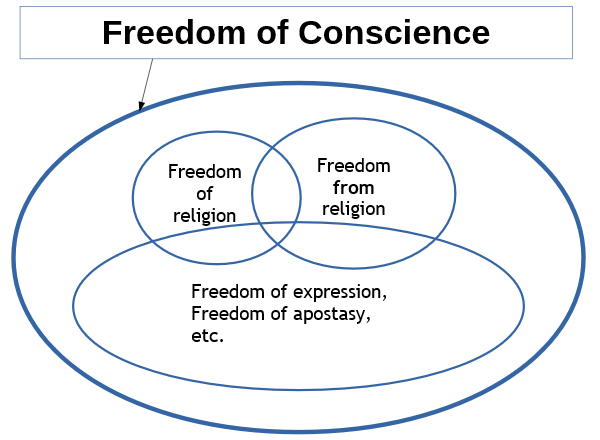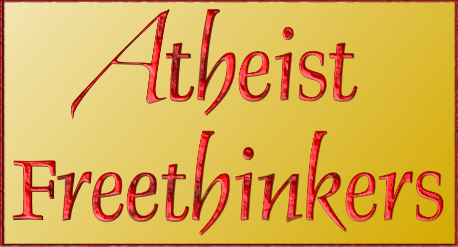David Rand
Talk presented at the Rationalist International Conference, Cambridge, UK, 27-28 July 2019.
You may also consult the slide presentation (format PDF) which accompanied this talk.
This article also appears in the magazine Humanist Perspectives, Spring 2020, Issue 212.
Introduction
The main thesis of my talk is that secularism is much more than mere religious neutrality, because the concept of separation between State and religions must be added and has implications that go far beyond neutrality.
Secularism is, in my estimation, very poorly understood in the English-speaking world because it is often interpreted as mere religious neutrality. In fact, I would say that secularism is practically unknown in the English-speaking world: many people talk about it a lot, and they even talk about religion-state separation, but that separation concept is rarely applied consistently, I will argue.
Defining Secularism
Secularism may be defined as consisting of four principles:
- Equality, i.e. equality of treatment for all.
- Freedom of conscience, including freedom of religion and freedom from religion, as well as other freedoms.
- Religious neutrality, i.e. State neutrality towards religions.
- Separation, i.e. separation between religions and State.
Some explanatory remarks about each point:
The first principle, Equality, includes equality between women and men, of course.

In the second principle, Freedom of conscience, freedom of religion is often included explicitly. I disagree with this, because freedom of conscience already includes it. Mentioning freedom of religion—without explicitly mentioning freedom from religion as well—gives undeserved priority to religion.
The third principle, Religious neutrality, if used in isolation, is an ambiguous expression because it has two very different interpretations, one of which does not even consider non-believers, as if atheists did not exist or were of no consequence. Those two interpretations are:
- Neutrality among religions, i.e. all religious belief systems, excluding non-religion or non-belief.
- Neutrality among all convictions, whether religious or non-religious, belief or non-belief.
The difference is that the first excludes non-believers (atheists, etc.) from consideration whereas the second includes non-believers. In the version of “secularism” proposed by John Locke, for example, the first interpretation applies.
The fourth principle, Separation, means that the State must be independent of, and autonomous with respect to, all religious institutions and belief systems. This principle is absolutely critical because without it, the third principle degenerates into the version of neutrality restricted to religious believers only. Furthermore, without separation, the first two principles are also compromised. The equality principle is compromised because atheists are not given equal treatment and because religions in general are often very misogynistic, thus threatening equality between women and men. Freedom of conscience of not only atheists but everyone, including believers, is also threatened by religious influences in the State.
Lockean Pseudosecularism

John Locke
In his famous A Letter Concerning Toleration published in 1689, English philosopher and physician John Locke proposed a society and a government which tolerated various religions. But he excluded Catholics as they could be expected to hold allegiance to a foreign prince. He was also resolutely atheophobic, claiming that, being without religion, an atheist could never be trusted.
Locke is probably the reference for secularism in the English speaking world, but I would call his vision pseudosecularism because of its assumption that everyone with any concept of ethics, any right to live in society with others, has a religion, and indeed a theistic religion. Indeed, Locke’s approach is no more than weak religious neutrality, including neither neutrality between belief and non-belief nor separation between religion and State. His atheophobia is completely unacceptable.
Thus, Lockean pseudosecularism is a truncated form of secularism and is communitarian by nature. Modern proponents of this programme simply correct Locke’s most glaring omissions by filling in the blanks, so to speak, by adding Roman Catholics and atheists – and possibly other groups or identities – to the mix. What these modern Lockeans fail to do is to propose the application of universal values, regardless of the individual’s religious affiliation if any. Furthermore, they fail to extend Locke’s model to include the other three aspects of secularism, i.e. equality, freedom of conscience and especially separation. Such atheists are dupes of the standard communitarian discourse which lionizes “diversity” as some sort of absolute, shining good.
Religious diversity is not an argument for secularism. Rather, it is an argument for religious neutrality at best. Secularism is required not just to keep the peace among competing religions, but also to keep religion in general from polluting public institutions with supernatural nonsense.
Countries where the religious landscape is homogeneous do not have a lesser need for separation between church and state. Even in a nation with very little religious diversity, even one in which a single religion is monolithically dominant, secularism is still necessary, and indeed perhaps even more necessary, in order to keep that powerful religion from interfering with the State, in order to protect citizens, especially female citizens, from the monolithic power of a religious institution.
Furthermore, the idea that the institutions of a secular state should in some way reflect the religious diversity of the country leads us directly to what is called “open secularism.” This travesty of secularism can be recognized by its lack of respect for separation between religions and state and by its promotion of religious representation in public institutions.
Republican Secularism
In other cultures, other variants of secularism have been proposed, the most important being organized around the principle of republicanism (the lower case “r” is important). In particular, the French tradition of “laïcité” is in my opinion the most advanced and enlightened form of secularism so far developed and is an example of republican secularism. It has inspired secularists in several other countries, such as Turkey, Mexico and others.
In the on-line dictionary Wiktionary, republicanism is defined as “The political ideology of being a citizen in a state as a republic under which the people hold popular sovereignty.” Republicanism may also be considered not so much an ideology as a pragmatic approach to governance based on science and rationality. In either case, republicanism implies a form of universalism, treating all citizens equally, regardless of their religious affiliation or lack thereof, and giving no privileges to any religion.
Atheism & secularism are not synonyms, but share a common foundation.
Of course atheism and secularism are not synonymous. The first is a personal stance adopted by the individual, whereas the second is a principle of governance. Nevertheless, they have a common foundation: the non-recognition of divine authority. For the individual atheist, this means not recognizing such authority in matters of personal morality. For the collectivity—that is, the secular State—it means not recognizing such authority in matters of legislation and in the functioning of state institutions.
However, and this is crucial, the secular state does not exclude religious believers; they participate, as do all citizens, whether believer or not. But, in the words of Barack Obama when he was a senator (2006-06-28), believers must “translate their concerns into universal, rather than religion-specific, values” which must be “amenable to reason.”
Secularism is to state governance as atheism is to personal morality. Both the secular state and the atheist individual reject divine command theory, the dogma which insists that morality and good government require conformity with the will of “God,” a will of which no-one can have any knowledge whatsoever. Thus, the intersection between secularism and atheism is the independence of morals and ethics from religious tenets, that is to say: separation of morals from religion.
Religious Neutrality vs. Secularism in Practice
Here are some practical examples which illustrate the distinction between religious neutrality and secularism.
| Approach | Religious Neutrality | Secularism |
|---|---|---|
| Constitutional and Legislative provisions | Non-sectarianism (i.e., religious neutrality) is declared. Example:
There is no mention of separation. Furthermore, this provision did not apply to states until the mid-20th century. |
Separation is declared. Example:
(The word “Churches” would no doubt be replaced by “Religions” if the law were written today.) |
| Freedom of Religion | Freedom of religion is declared, but without condition, effectively absolute. Example:
|
Freedom of religion is declared, but is not absolute. Example:
Déclaration des droits de l’Homme et du Citoyen, 1789, Article 10: “No one may be disturbed because of his/her opinions, even religious, provided that their expression does not trouble public order as established by law.” |
| Prayers before legislative sessions and municipal council meetings. | Several prayers, reflecting the religious demographics of the population. Examples:
|
No prayer. Possibly a moment of silence. Example:
|
| Religious symbols worn by public servants | Allowed, even while on duty. Examples:
|
Banned while on duty. Example:
|
| Religious symbols worn by new citizens during swearing-in ceremony | Allowed, even during the ceremony. Example:
|
Banned during ceremony. Example:
|
| Politicians seeking votes | Politicians practice clientelism, seeking votes of particular ethno-religious “communities” by wooing and pandering to self-appointed community leaders. | Politicians and governments appeal to all citizens universally and avoid targeting special interest groups. |
| Management of religious diversity | Multiculturalism, a euphemism which implies communitarianism, with recognition of “communities,” especially ethno-religious groups. Example:
|
Universalism, treating all citizens equally, regardless of their religious affiliation (or other particular identity) or lack thereof.
The State is blind (or should be) to the religious or non-religious identity of the individual. |
| Freedom of Speech | Privileges granted to religion by either restricting criticism of religion or by allowing religions to propagate hatred. Examples:
|
No privileges granted to religions. No legal recognition for so-called “blasphemy.” No restrictions on criticism of ideas and ideologies.
Examples: There are many countries with no remaining blasphemy law (Canada, U.K., Ireland, France, etc.) but in general freedom of speech is nevertheless threatened by laws or policies which do not explicitly mention “blasphemy” but may impose a form of censorship. |
Separation & Neutrality, Both in Fact & in Appearance
A major implication of separation between State and religion is that public services must be neutral both in fact and in appearance and that such religious neutrality must be of the second, strong kind. That is, it is not acceptable to allow religious influence in which all religious participate equally, because that would obviously violate separation. At the same time, the State must not actively promote atheism either, although it must be non-religious and thus functionally and passively atheistic.
For the State to be independent of religion and to show itself to be free of religious influence, both its physical installations and its human agents must be free of religious symbolism. Displaying a religious symbol on the wall of a State building or allowing a State employee to wear a visible religious symbol while on the job are both clear and obvious violations of religion-State separation. In either case, the religious symbol constitutes at the very least passive endorsement by the State of the religion being symbolized. An anti-religious or atheist symbol would also be unacceptable in both situations and for similar reasons.
Religion is, or should be, a private matter. When a religion practices exhibitionism, there is an obvious political purpose, a purpose which has no place in civic institutions.
When a public servant wears a religious symbol while on the job, they are saying that their religious affiliation is more important than their role as a representative of the State whose mandate is to serve the public. They are saying that their individual freedom of expression takes precedence over the freedom of conscience of the users and students whom they serve. This is backwards.
When the State bans the wearing of religious (or anti-religious) symbols by public servants while on the job, it is saying that it is committed to treating all citizens, all members of the public, equally and fairly, regardless of their religion or lack thereof. The State thus undertakes to respect the freedom of conscience of the users of public services and students in schools.
When a public servant refuses to comply with a ban on the wearing of religious symbols while on the job, they are saying that their religious practice is so fanatical, so fundamentalist, that they cannot even present a neutral facade when it is their duty to do so.
Here, I must introduce an important nuance: There is no such thing as a religious “obligation” except, of course, an obligation resulting from external coercion. To be precise, a person who participates in religious activities, or who has specific behaviours based on religious belief, or who wears religious symbols, has either freely chosen his or her religious behaviour or has been coerced into it. In the latter case, the person is a victim of abuse, and it is the secular State’s duty to help end that abuse, especially if the person involved is a minor. In the first case, where there is no coercion, the person always has a choice, because they can choose whether or not to respect the “obligations” of the religious tradition which they have chosen to adopt.
Finally, if the State is spineless or complacent and allows the recalcitrant employee to keep their religious symbol while on the job, then the State is implicitly recognizing that the religious symbol is an innate part of the person, that they cannot not wear it. The State thus essentialises the employee’s religious affiliation, as if it were immutable like genetics or race and as if the “obligation” to wear the symbol were indeed divinely imposed. The State thus endorses the employee’s religion. Unacceptable!
Case Study: Secularism in Quebec
The Canadian province of Quebec is in the avant-garde of secularisation. It has made significant progress in that direction in the recent past, while most other countries stagnate or move backwards in the direction of greater religious interference in government.
Here is a summary of events in the recent past in Quebec relevant to secularism:
- 2007-2008: Bouchard-Taylor Commission mandated to study the controversy surrounding “reasonable accommodations” (never reasonable when religious). Recommendation: ban religious symbols for State employees in positions of coercive authority only (police, judges, prosecutors, prison guards). Not implemented.
- 2013-2014: A Charter of Secularism proposed which would have banned religious symbols throughout the public service, strongly supported by the population and by all Quebec secularists. But government voted out of office in April 2014 so the Charter dies.
- 2016: New government passes Bill 62 claiming to “foster adherence to State religious neutrality” but only bans face-coverings (not religious symbols) in public services, and allows “accommodations.” Even this extremely weak law is too much for anti-secularists.
- January 2017: Massacre at a Quebec City mosque. Catholic philosopher Charles Taylor repudiates the recommendation of Commission he co-presided, implying that promoting secularism causes anti-Muslim violence. This is slander. On the contrary, adoption of the Charter would have reduced social tensions. (See decision of judge Yergeau.)
- 2018-10-01: A new government is elected, the Coalition Avenir Québec (CAQ), a new political party. Within 48 hours, the CAQ announces its intention to enact secular legislation.
- 2019-03-28: Draft Bill 21, “An Act respecting the laicity of the State,” is proposed by the new government. The government also commits itself to removing that damn crucifix (the one in the National Assembly chamber) when the Bill becomes law. A motion to that effect is passed unanimously by the legislature.
- 2019-06-16: Bill 21 is passed into law!

2019-07-09: Crucifix removed from National Assembly
- 2019-07-09: That notorious crucifix hanging above the speaker’s chair in the National Assembly chamber is finally withdrawn! Good riddance!
- 2019-07-18: Judge Michel Yergeau rejects an attempt to suspend Bill 21 while it is being contested in the courts by the National Council of Canadian Muslims and the Canadian Civil Liberties Association. He comments that hostility to religious minorities is not caused by the law, as the plaintiffs allege; on the contrary, the law is an attempt to curb such hostility.
What Bill 21 Does
- Bans religious symbols worn by public servants in positions of authority – i.e. as recommended by the B-T Commission but with the addition of public school teachers.
- Bans face-coverings when providing (employees) or receiving (users) public services.
- Contains a simple, clear definition of secularism (similar to my definition above).
- Contains a simple, clear definition of “religious symbol.”
- Bans religious accommodations.
- Contains a “grandfather” clause, i.e. an exemption for employees who are in the same job as they were on March 27th (before publication of the draft bill).
- Stipulates measures to monitor the application of the law and to respond to instances of noncompliance if any.
- Adds the principle of State secularism to the Quebec Charter of Rights and Freedoms, thus giving it near-constitutional status.
- Declares a new right, “that all persons have the right to lay parliamentary, government and judicial institutions, and to lay public services…” where “lay” means “secular.”
- HOWEVER, it contains a provision, added at the last minute, which prevents State secularism from being used to modify a State building, thus allowing religious symbols to remain!
What Bill 21 Does Not Do
- Does not ban religious symbols for all public servants.
- Does not ban religious symbols for teachers in private schools and for workers in child-care centres.
- Does not ban religious symbols worn by MNAs (Members of National Assembly). This is inconsistent with removal of the crucifix from the legislature.
- Does not ban all religious symbols displayed as part of State buildings.
- Does not deal with the significant fiscal privileges (tax exemptions, partial funding of private religious schools, etc.) which religious institutions enjoy.
- Neither cancels nor reforms the notorious Ethics and Religious Culture (ERC) program in Quebec school, a compulsory course at all levels which indoctrinates children into a communitarian and sugar-coated view of religions.
Reactions to Quebec’s Bill 21
Bill 21 is good, secular legislation. It is very moderate, even timid. Yet, there has been a tsunami of irrational and dishonest reactions to this legislation.
There is a misconception that Bill 21 discriminates against some minorities. This is false. Bill 21 treats all religions equally. And it benefits everyone, including the religious, whether in a minority or not, by expanding rights because it guarantees secular public services to all. Bill 21 ends some religious privileges (unfortunately not all) and protects freedom of conscience by extending rights.
Enemies of Bill 21 claim that State employees wearing religious symbols while on duty pose no problem whatsoever. This is absurd. Have they never heard of the advertising industry? Companies spend millions of dollars on advertising, because it works. Campaigns which are called “advertising” in the domain of commerce are called “proselytising” in the domain of ideologies and religions. The two words are basically synonyms. And just as the aim of the advertiser is not always to make an immediate sale, the aim of the proselytiser is not always to convert someone to their ideology or religion. Often, the goal is simply to publicise and normalise the brand, to render it commonplace and accepted by everyone everywhere, so that its presence will not be questioned.
Enemies of Bill 21 often claim that the Islamic veil, for example, is just an article of clothing, worn by choice. And yet, it is so overwhelmingly important to the wearer that she cannot even remove it when working as, say, a police officer! Apparently the individual has an incontrovertible religious obligation to wear their religious symbol. It is an essential part of their person, their identity, so they say. Well, I ask, which is it? Is it a choice or is it an obligation? The speciousness and dishonesty of this ploy is obvious.
The only “minority” negatively affected by Bill 21 is religious fundamentalists and fanatics who seek to impose their politico-religious ideology everywhere, even in State institutions. This is especially true of Islamists who falsely claim to speak for all Muslims.
The reaction of many mainstream media and politicians has been extremely hostile and insane, especially from English Canada, where secularism is basically unknown, even though many use that word. In practice, only religious neutrality is supported in the English-speaking world and, as I have explained above, mere religious neutrality is a recipe for recognizing and extending religious privileges.
The role of much of the so-called “left” and those who emulate it has been shameful in the extreme. Even many atheists and humanist organisations who claim to be secularists have capitulated to religious obscurantism by conforming to the dominant ideology of communitarianism which idolises and essentialises religious identity while abandoning universalism and Enlightenment values. These pseudo-leftists systematically comply with several Islamist strategies:
- Conflation of race with religion. thus essentialising religious affiliation and facilitating specious accusations of “racism” against secularists.
- The rhetoric of inversion, whereby Islamists re-brand privileges as rights and thus hijack and subvert human rights.
- Weaponisation of ethnic bigotry (a.k.a. racism) against Quebecers—a major theme throughout Canadian history—exploiting this bigotry in their fight against secularism.
On the other hand, polls have shown that large numbers of Canadians outside Quebec are sympathetic towards the religious symbol ban. The percentage is more modest than the overwhelming majority inside Quebec, but it shows that there is a big disconnect between what the population thinks and what most media and politicians peremptorily and arrogantly declare one must think. The situation borders on the Orwellian. There is extreme intolerance of any intellectual diversity on this issue.
Republican Secularism: An Invaluable Heritage
Republican secularism is currently under great threat from politicised religions, in particular from political Islam, and from the communitarian regressives (who falsely claim to be leftist or progressive) who are the objective allies of political Islam. That threat is obvious in the toxic reaction to Bill 21. But secularism is under great threat in many countries, and in particular in France, the birthplace of the best variant of secularism we have available. Extreme right-wing religious obscurantism and its objective allies would like nothing more than to kill republican secularism at its source.
This is a fight between religious fundamentalism, fanaticism and obscurantism on the one hand and secularism, Enlightenment values, human rights and democracy on the other.
We must do everything in our power to preserve, protect and extend secularism, true secularism. As atheists and secularists, we of Libres penseurs athées—Atheist Freethinkers and our allies of the Rassemblement pour la laïcité (a Quebec coalition of secularists) celebrate the success which the adoption of Bill 21 represents, despite its weaknesses, and will continue our work towards full secularism.


 AFT on Twitter
AFT on Twitter Amis et amies de Libres penseurs athées
Amis et amies de Libres penseurs athées Atheist Alliance International (AAI)
Atheist Alliance International (AAI) Atheist Census Canada
Atheist Census Canada Humanist Perspectives
Humanist Perspectives Libres penseurs athées
Libres penseurs athées LPA-AFT on Heylo
LPA-AFT on Heylo LPA-AFT Youtube Channel
LPA-AFT Youtube Channel Rassemblement pour la laïcité (RPL)
Rassemblement pour la laïcité (RPL)
Using a single English word, such as secularism, to describe or define something which adds to the original meaning “the principle of separation of the state from religious institutions” can lead to confusion, even when subtle differences in label (ie Secularism vs secularism). TO my mind, you are describing secular philosophy, or some other double barreled label.
There is nothing truly unusual about this (cf democrats and Democrats), and it is certainly short, and helpful.
Do you have other sources which align with your definition? Will such a definition of secularism be understood easily in literature and documents?
My definition of secularism is rather standard and differs little from that used by many others. See for example the definitions given by:
I have not redefined secularism. My point it that the separation part, which so many people claim to recognize, is simply not applied (at least not consistently) in the English-speaking world.
Thanks. Good article.
Excellent article. The other great misconception is that Islam is just another religion, when in philosophy and in practice it is actually a sectarian political movement set on world domination, not unlike Naziism or White Supremicism. The religion part is just a bunch of bastardized precepts stolen from Judeo-Christian tradition (which were themselves stolen from more ancient contemporary traditions).
Everyone who isn’t afraid of Islam and what it can lead to (Islamophobic) is either misinformed or deluded. Islam has absolutely no place in a modern democracy.